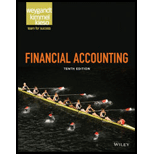
Concept explainers
(a)
Worksheet: A worksheet is a tool that is used while preparing a financial statement. It is a type of form having multiple columns and it is used in the adjustment process. The use of a worksheet is optional for any organization. A worksheet can neither be considered as a journal nor a part of the general ledger. Usually organizations use Microsoft Excel in order to use a worksheet electronically.
Classified
In order to improve the ease of understanding, a classified balance sheet is used. In a classified balance sheet, various standard classifications and sections are used to classify all the similar assets and similar liabilities together. The items having similar economic characteristics are put in the same group so that the users of the statement can easily understand the items.
Classification Heads
- Current Assets
- Long-Term Investments
- Property Plant and Equipment
- Intangible Assets
- Current Liabilities
- Long-Term Liabilities
Stockholder’s Equity
Accounting rules for
- To Increase balance of the account: Debit assets, expenses, losses and credit all liabilities, capital, revenue and gains.
- To Decrease balance of the account: Credit assets, expenses, losses and debit all liabilities, capital, revenue and gains
Closing entries: Closing entries are those journal entries which are passed to transfer the balances of temporary accounts to the permanent accounts. These are passed at the end of the accounting period, to transfer the final balance.
Rules for closing entries:
- Debit the account: All temporary accounts with credit balances.
- Credit the account: All temporary accounts with debit balances
Ledger Account
A ledger account helps to prepare the financial statements. The accounts of all the items are prepared separately such as assets, liabilities, revenues, expenses, owner’s equity and so on. The ledger accounts along with their balances are further posted to the
The general ledger accounts are represented graphically through the T Accounts.
Post-Closing Trial Balance: Post closing trial balance is prepared, after journalizing the closing entries, and posting them to the respective ledgers.
To Prepare: a complete worksheet.
(b)
To Prepare: the classified balance sheet of J Company:
(c)
To Record: the adjustment entries of Company A.
(d)
To Journalize: The closing entries.
(e)
To Prepare: the post-closing trial balance.
Want to see the full answer?
Check out a sample textbook solution
Chapter 4 Solutions
Financial Accounting
- Can you help me solve this general accounting question using valid accounting techniques?arrow_forwardHelp me Which of the following accounts is a permanent account?a) Rent Expenseb) Sales Revenuec) Accounts Payabled) Dividendsarrow_forwardCan you explain the correct methodology to solve this financial accounting problem?arrow_forward
- Why does sustainability impact measurement require special approaches? a. Standard measures capture all impacts b. Environmental factors remain irrelevant c. Traditional methods work fine d. Long-term environmental effects demand unique valuation methodsarrow_forwardPlease show me the correct approach to solving this financial accounting question with proper techniques.arrow_forwardCan you explain this general accounting question using accurate calculation methods?arrow_forward

 AccountingAccountingISBN:9781337272094Author:WARREN, Carl S., Reeve, James M., Duchac, Jonathan E.Publisher:Cengage Learning,
AccountingAccountingISBN:9781337272094Author:WARREN, Carl S., Reeve, James M., Duchac, Jonathan E.Publisher:Cengage Learning, Accounting Information SystemsAccountingISBN:9781337619202Author:Hall, James A.Publisher:Cengage Learning,
Accounting Information SystemsAccountingISBN:9781337619202Author:Hall, James A.Publisher:Cengage Learning, Horngren's Cost Accounting: A Managerial Emphasis...AccountingISBN:9780134475585Author:Srikant M. Datar, Madhav V. RajanPublisher:PEARSON
Horngren's Cost Accounting: A Managerial Emphasis...AccountingISBN:9780134475585Author:Srikant M. Datar, Madhav V. RajanPublisher:PEARSON Intermediate AccountingAccountingISBN:9781259722660Author:J. David Spiceland, Mark W. Nelson, Wayne M ThomasPublisher:McGraw-Hill Education
Intermediate AccountingAccountingISBN:9781259722660Author:J. David Spiceland, Mark W. Nelson, Wayne M ThomasPublisher:McGraw-Hill Education Financial and Managerial AccountingAccountingISBN:9781259726705Author:John J Wild, Ken W. Shaw, Barbara Chiappetta Fundamental Accounting PrinciplesPublisher:McGraw-Hill Education
Financial and Managerial AccountingAccountingISBN:9781259726705Author:John J Wild, Ken W. Shaw, Barbara Chiappetta Fundamental Accounting PrinciplesPublisher:McGraw-Hill Education





